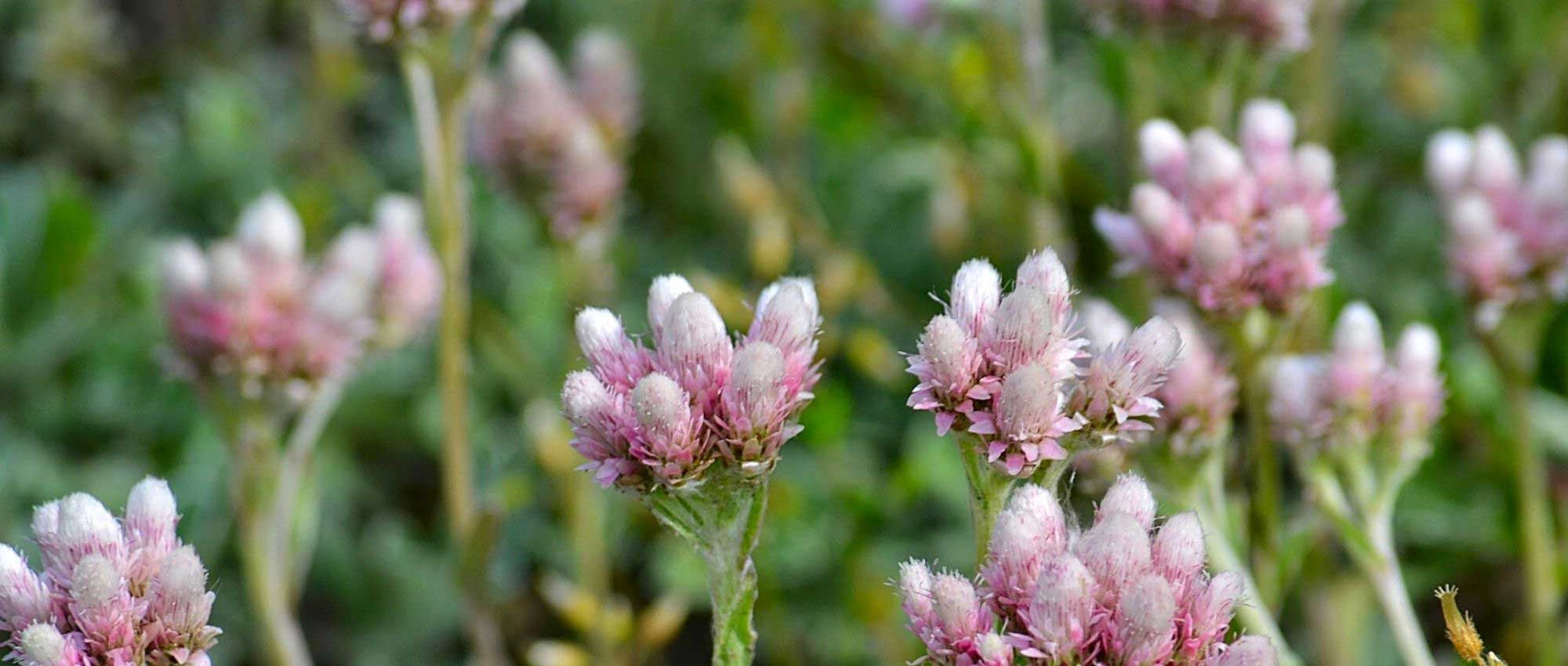
Antennaria: planting, growing, and care
Contents
Antennaria in a nutshell
- Antennaria is a small perennial that offers lovely pink, red, or white flowers in spring
- Its evergreen, grey-green foliage is appreciated, often with a silvery hue
- It is particularly suited to poor, stony soils
- It is an undemanding plant that is drought and cold resistant
- It has a very soft, wooly appearance
- It easily finds its place in a sunny rock garden, on a green roof, or in any ungrateful, well-draining soil where other plants struggle to grow
A word from our expert
The dioecious Antennaria is a charming little perennial. It has a very soft, wooly appearance, both in its leaves and its flowering, which earns it the nickname “cat’s foot”! In May-June, it produces small head-like flowers in white, pink, or red, as seen in the variety Antennaria dioica ‘Rubra’. This is a small plant, typically not exceeding 20 cm in height when in bloom. Its leaves are evergreen and have a grey-green, slightly silvery colour. It spreads gently and forms a true groundcover.
Antennaria thrives in full sun. It is perfect for challenging terrains, poor, lean, and stony soils, where other plants struggle to grow. It is an undemanding plant that requires little! It will easily find its place in a sunny rock garden or on a green roof, alongside other plants that enjoy dry, stony soils, such as houseleeks, sedums, Cerastium tomentosum, Arabis caucasica… The Antennaria requires very little maintenance and can self-seed in the garden.
Botany
Botanical data
- Latin name Antennaria sp.
- Family Asteraceae
- Common name Cat's foot, mountain everlasting
- Flowering in May-June
- Height between 10 and 25 cm
- Exposure full sun
- Soil type well-drained, poor, rather dry and stony
- Hardiness between -15 and -20 °C.
Antennaria are small, spreading perennial plants, native to temperate and cold regions of the Northern Hemisphere. They are found notably in Europe, northern Asia, and Alaska. Antennaria dioica grows wild in France, primarily in mountainous regions! Today, it is rarely found below 500 m in altitude (whereas it was once present in the plains), but it can be encountered up to 2,800 meters. It mainly grows in rocky meadows, pastures, heaths, and dry lawns, on rather acidic soil. As it generally grows in cold regions or at altitude, Antennaria is obviously a very hardy plant! It can withstand temperatures down to at least -15 °C, even -20 °C.
There are about sixty species of Antennaria, but the most well-known is undoubtedly Antennaria dioica, which comes in several varieties. Antennaria belongs to the Asteraceae family, like daisies, buttercups, and sunflowers… These plants are particularly recognisable by their flowering in heads, which resemble a single flower but are actually a cluster of many tiny flowers.
Whether through its foliage or its flowering, Antennaria has a soft, woolly appearance… This is surely why it is nicknamed “cat’s foot”!
Antennaria is a small spreading plant, measuring between 10 and 20 cm (up to 30 cm at most when in flower). Antennaria produces offsets, allowing it to spread gradually, thus forming a groundcover. As it spreads and forms a small carpet with its rosettes of leaves, it prevents weeds from growing. One plant of Antennaria can eventually cover up to 1 square metre.
The cat’s foot forms fairly dense rosettes of leaves with a beautiful grey-green, slightly silvery colour. Its leaves are evergreen and woolly. They measure about 4 cm long, are spatulate, and have a single central vein. The underside of the lamina is covered with white hairs. In addition to the basal leaves, Antennaria also bears small, fine leaves that are applied along the flowering stem.
The leaves of Antennaria plantaginifolia are slightly wider and rounder than those of Antennaria dioica, and they have several parallel veins, reminiscent of plantain leaves.

The leaves of Antennaria dioica and those of Antennaria plantaginifolia (photo by Agnieszka Kwiecień)
Antennaria usually flowers in May-June, but it is often a bit later in mountainous regions, until July or August. It then produces a flowering stem that rises above the foliage, though not very high (generally up to 20 cm). This stem bears corymbs of 3 to 8 small, rounded heads, quite dense, which themselves group together small flowers, surrounded by dry bracts. Depending on the varieties, the flowers can be red, as in Antennaria dioica ‘Rubra’, pink, or even white, as in Antennaria dioica ‘Borealis’ or Antennaria plantaginifolia. The flowering stem also bears small leaves, applied against it.
As its name suggests, the cat’s foot is dioecious: there are male plants, which bear stamens, and female plants, which bear pistils and will produce seeds. Male plants generally have slightly smaller heads, with broader and shorter bracts. The flowers of Antennaria dioica are pollinated by butterflies, which carry pollen from male flowers to female flowers.
Once flowering is complete, the flowers dry on the stem and produce seeds. These are small achenes topped with a plume, allowing them to fly away, much like dandelion seeds! When it is happy, Antennaria can self-seed spontaneously.
In addition to its ornamental interest, the cat’s foot is also a medicinal plant, with soothing properties for the throat. It is particularly useful for treating coughs, sore throats, bronchitis, and tracheitis. It can be used in herbal tea or as a mother tincture.

The blooming of Antennaria dioica flowers, and the fruits (plumed achenes) of Antennaria plantaginifolia (photos: Dominicus Johannes Bergsma, V.R. Ranta, and Krzysztof Ziarnek)
“`
Read also
15 plants for a sunny rockeryThe main varieties
The most popular varieties
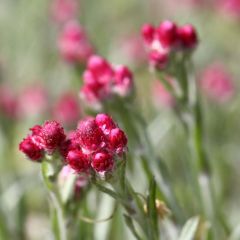
Antennaria dioica Rubra - Mountain Everlasting
- Période de floraison June to August
- Hauteur à maturité 15 cm
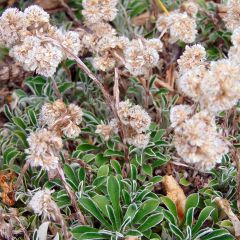
Antennaria dioica var. borealis
- Période de floraison June, July
- Hauteur à maturité 15 cm
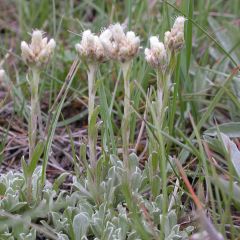
Antennaria plantaginifolia
- Période de floraison June, July
- Hauteur à maturité 15 cm
Planting Antennaria
Where to plant?
Antennaria thrives in full sun, but it can also tolerate light partial shade. It prefers rather poor and dry soil, even stony. In any case, the substrate must be well-draining, as it does not appreciate stagnant moisture. It is a very undemanding plant that does not require rich humus soil. As for pH, Antennaria seems to prefer neutral to acidic substrates.
Antennaria is perfect for greening up challenging areas where other plants would struggle to grow! It will find its place in a rockery, on a green roof, or on a stone wall… It can even thrive in spots with very little soil. It can even fit into the gaps of paving.
Discover our article “Creating a rockery: our tips for success”
When to plant?
We recommend planting Antennaria in spring, around April, or in autumn (September to October).
How to plant?
- Dig a small planting hole, or make space for it between the stones of a rockery, on a green roof, or in a stone wall, creating a small pocket of substrate (for example, bring in soil mixed with a bit of coarse sand).
- Remove the Antennaria from its pot and plant it.
- Fill in by replacing some soil around it and lightly firming it down, without burying it too much.
- All that’s left to do is water!
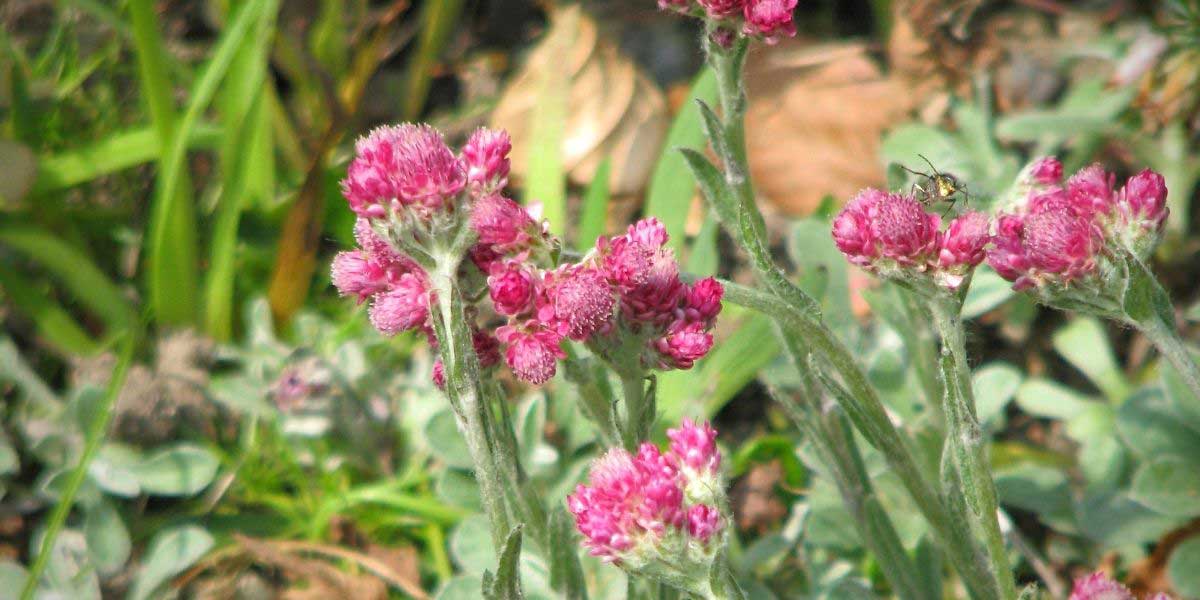
Antennaria dioica ‘Alex Duguid’ (photo peganum)
Care
Undemanding plant par excellence, Antennaria requires very little maintenance. It is resistant to drought, cold, and is not susceptible to diseases and pests.
We recommend watering it in the weeks following planting, and then during dry spells in the first year. After that, it will manage without watering.
It is also advisable to weed if you see any adventive plants growing around the Antennaria, but afterwards, these should form a carpet that limits the growth of unwanted herbs.
You may optionally cut the dried flowers for aesthetic purposes, but this will also prevent it from self-seeding.
You can also harvest the dried flowers of Antennaria dioica to make herbal teas, as it is an effective medicinal plant, particularly for treating bronchitis and sore throat.
Multiplication
You can multiply Antennaria by dividing the clumps or by collecting the seeds and sowing them. Division is easier and quicker, but sowing allows you to obtain a larger number of young plants without disturbing those already in place. When it is happy, Antennaria can also self-seed in the garden!
Sowing
Antennaria seeds are sown in early spring.
- Prepare a pot by filling it with light, well-draining compost (for example, a mix of compost and sand, or seed compost).
- Water it to ensure it is well moist.
- Place the seeds on the surface.
- Lightly cover them with a little substrate.
- Place your seedlings under a cold frame in a bright location.
- Continue to water regularly, but without overdoing it, to prevent the substrate from drying out.
- As soon as the seedlings reach a size that allows for handling, transplant them into individual pots.
Clump division
Dividing clumps of Antennaria is quite easy, as the plant tends to produce offsets.
Choose well-established clumps that have started to spread, then gently separate them and replant directly in a new location or in pots with well-draining substrate.
Pairing ideas
Pair Antennaria with other plants that thrive in poor, dry soils. Consider, for example, sedums, houseleeks, Cerastium tomentosum, Dryas suendermanii, Geranium cinereum, Armeria maritima… Also discover the fern Cheilanthes lanosa, a species well-suited to heat and drought. To add colour, plant helianthemums, Phlox subulata, and Phlomis fruticosa. To introduce lightness, incorporate some small grasses, such as Stipa, carex, or fescues. These undemanding plants will be perfect for creating a splendid rock garden, or even a green roof. You can also pair them with lavenders, cistus, or creeping thyme to create a Mediterranean atmosphere.
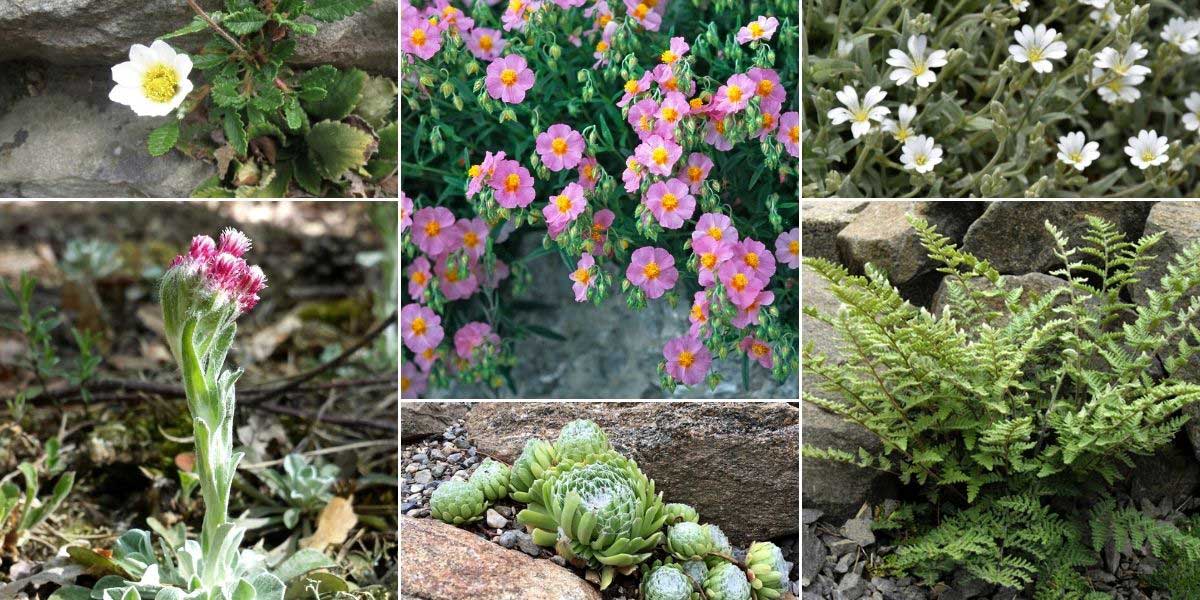
Antennaria dioica integrates easily into a rock garden, alongside other perennials that thrive in poor, stony soils! Dryas suendermannii, Helianthemum ‘Lawrensons Pink’, Cerastium tomentosum, Antennaria dioica, Sempervivum arachnoideum, and Cheilanthes lanosa (photos: David Short / Friedrich Strauss – MAP / Krzysztof Golik / Stefan Lefnaer / Kristine Paulus / ghislain118)
You can also use Antennaria dioica to create a rock garden of alpine plants. Assemble a collection of perennial plants that, like Antennaria, are naturally found in mountainous regions. They are perfectly hardy and generally prefer stony, well-draining soils. For example, you can plant alongside Antennaria, Edelweiss, Silene acaulis, Lewisia cotyledon, Gentiana acaulis, and pasque flowers… Also enjoy the lovely finely cut foliage of Alchemilla alpina. For more ideas and tips, check out our guide on alpine perennial plants!
Useful resources
- Discover Antennaria dioica ‘Rubra’ with red flowers, as well as Antennaria dioica ‘Borealis’ and Antennaria plantaginifolia, which offer lovely white flowers.
- To pair with Antennaria, check out our article: “15 plants for creating a sunny rockery”.
- Our tips to create a green roof.
- Subscribe!
- Contents































Comments